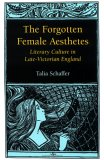Forgotten Female Aesthetes
Sep. 22nd, 2017 04:52 pm The Forgotten Female Aesthetes: Literary Culture In Late Victorian England by Talia Schaffer
The Forgotten Female Aesthetes: Literary Culture In Late Victorian England by Talia SchafferMy rating: 5 of 5 stars
I love this book. Schaffer is such a good writer. I think it's so hard to write academic criticism well. The writer has to straddle the line between knowing her stuff/making a convincing argument and coming off like a pretentious twit who's just interested in proving how large her vocabulary is and how convoluted a sentence she can write. The longer I am in the academy, the less patience I have for dense, impenetrable academic writing. Life is too short to read someone masturbating (painfully, no less!) on the page. Schaffer's writing is not conversational, but it's not convoluted either; her writing is clear and convincing. I get a sense of who she is as a scholar and a thinker; her writing is formal, but she has not attempted to absent herself entirely from the process, a conceit I find tedious in a great deal of academic writing (as if our passions and interests and biases as scholars do not inform our work).
As a Ouida scholar, what mainly draws me to this book is Schaffer's argument that Ouida is a female Aesthete who can be credited with popularizing the witty, epigrammatic language that will later become characteristic of male Aesthetes like Wilde. She also positions Ouida and other female Aesthetes as a direct influence for Modernist writers; her comments about the way that Virginia Woolf's A Room of One's Own explicitly denies the lives and literary output of late Victorian women writers in order to create its argument that a female literary tradition doesn't exist are quite compelling (and even shocking) in this context. Identifying Ouida as an Aesthete also helps us to understand some of the seemingly inexplicable choices she made in her personal life (the way she dressed, her love of hothouse flowers, etc) as an attempt to live out the principles of Aestheticism.
I really enjoyed learning about female some writers I didn't know anything about (Who's going to immediately start reading Lucas Malet? This gal) and developing a greater understanding of Aestheticism itself. I was also fascinated to learn that Thomas Hardy plagiarized Jude the Obscure from a Lucas Malet novel and no one caught it at the time. Schaffer puts enough of their writing side by side that the plagiarism is undeniable.
Highly, highly recommend this as a very readable work that helps define Aestheticism, tells us about the lives and literary works of both male and female Aesthetes, and helps us understand the relationship of Modernism to the Aesthetic Movement.
View all my reviews